light SUBARU WRX 2016 User Guide
[x] Cancel search | Manufacturer: SUBARU, Model Year: 2016, Model line: WRX, Model: SUBARU WRX 2016Pages: 594, PDF Size: 19.43 MB
Page 28 of 594

Function settings A SUBARU dealer can change the settings of the functions shown in the following table to meet your personal requirements. If your
vehicle is equipped with a multi function display, the settings for some of these functions can be changed using the display. Contact the
nearest SUBARU dealer for details. For details, refer to “ Multi function display ” F 3-48.Item Function Possible settings Default setting
Alarm system Alarm system Operation/Non-operation Operation
Monitoring start delay time (after closure of doors) 0 seconds/30 seconds 30 seconds
Impact sensor operation (only models with shock
sensors (dealer option)) Operation/Non-operation Non-operation
Passive arming (models without “ keyless access with
push-button start system ” ) Operation/Non-operation Non-operation
Dome light and map lights (models with moonroof)
illumination ON/OFF OFF
Keyless access (if equipped) Hazard warning flasher* Operation/Non-operation Operation
Audible signal Operation/Non-operation Operation
Audible signal volume* Level 1 - 7 Level 5
Door unlock selection function (driver ’ s door unlock) Driver ’ s door only/All doors Driver ’ s door only
Remote keyless entry system Hazard warning flasher* Operation/Non-operation Operation
Audible signal Operation/Non-operation Operation
Audible signal volume* Level 1 - 7 Level 5
Key lock-in prevention Key lock-in prevention Operation/Non-operation Operation
Defogger and deicer system for models
with the automatic climate control sys-
tem* Rear window defogger, outside mirror defogger and
windshield wiper deicer Operation for 15 minutes/
Continuous operation Operation for 15
minutes
Dome light Operation of dome light/map light OFF delay timer OFF/10 seconds/20 sec-
onds/30 seconds 30 seconds
Map light (models with moonroof)
– CONTINUED –23
Page 29 of 594

Item Function Possible settings Default setting
Battery drainage prevention function Battery drainage prevention function Operation/Non-operation Operation
Seatbelt warning Sounds a chime while driving Operation/Non-operation Operation
Auto on/off headlights (if equipped)* Sensitivity of the operation of the auto on/off headlights Low/Normal/High/Very high Normal
Welcome lighting* Approaching (operation of timer) OFF/30 seconds/60 sec-
onds/90 seconds 30 seconds
Exiting (operation of timer)
One-touch lane changer Operation of the one-touch lane changer Operation/Non-operation Operation
*: The settings can be changed by the customer using the multi function display.
24
Page 30 of 594

Front seats ........................................................... 1-2Manual seat ........................................................ 1-4
Power seat (driver ’ s seat – if equipped) ... ............ 1-5
Head restraint adjustment .................................... 1-5
Seat heater (if equipped) .................................... 1-6
Rear seats ............................................................ 1-7Head restraint adjustment .................................... 1-8
Folding down the rear seatback ........................... 1-9
Seatbelts ............................................................. 1-11Seatbelt safety tips ............................................. 1-11
Emergency Locking Retractor (ELR) ................... 1-13
Automatic Locking Retractor/Emergency Locking
Retractor (ALR/ELR) ......................................... 1-13
Seatbelt warning light and chime ........................ 1-13
Fastening the seatbelt ........................................ 1-13
Seatbelt maintenance ......................................... 1-16
Front seatbelt pretensioners ............................. 1-17Seatbelt with shoulder belt pretensioner .. ........... 1-17
Seatbelt with shoulder belt and lap belt
pretensioners ................................................... 1-18
System monitors ................................................ 1-20
System servicing ................................................ 1-20 Precautions against vehicle modification ............ 1-21
Child restraint systems ..................................... 1-21Where to place a child restraint system .............. 1-23
Choosing a child restraint system ...................... 1-24
Installing child restraint systems with ALR/ELR
seatbelt ........................................................... 1-24
Installing a booster seat ..................................... 1-28
Installation of child restraint systems by use of
lower and tether anchorages (LATCH) .............. 1-29
Top tether anchorages ....................................... 1-32
*SRS airbag (Supplemental Restraint
System airbag) ................................................ 1-33Models with SRS airbags and lap/shoulder
restraints for driver, front passenger, and
window-side rear passengers . .......................... 1-33
Components ...................................................... 1-36
SUBARU advanced frontal airbag system ........... 1-38
SRS side airbag and SRS curtain airbag ............. 1-50
SRS airbag system monitors .............................. 1-57
SRS airbag system servicing ... .......................... 1-58
Precautions against vehicle modification ............ 1-59Seat, seatbelt and SRS airbags 1
Page 31 of 594
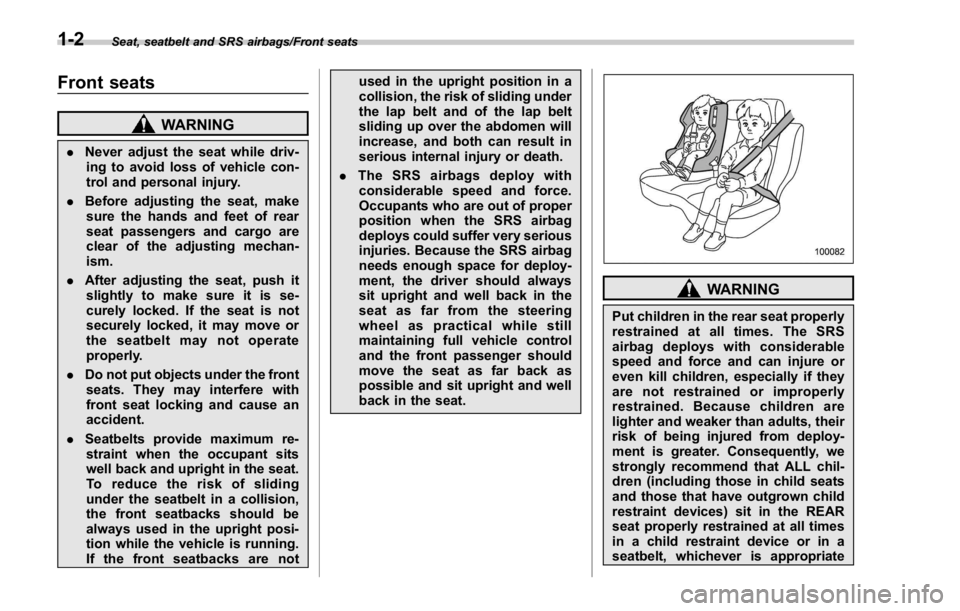
Seat, seatbelt and SRS airbags/Front seats
Front seats WARNING. Never adjust the seat while driv-
ing to avoid loss of vehicle con-
trol and personal injury.
. Before adjusting the seat, make
sure the hands and feet of rear
seat passengers and cargo are
clear of the adjusting mechan-
ism.
. After adjusting the seat, push it
slightly to make sure it is se-
curely locked. If the seat is not
securely locked, it may move or
the seatbelt may not operate
properly.
. Do not put objects under the front
seats. They may interfere with
front seat locking and cause an
accident.
. Seatbelts provide maximum re-
straint when the occupant sits
well back and upright in the seat.
To reduce the risk of sliding
under the seatbelt in a collision,
the front seatbacks should be
always used in the upright posi-
tion while the vehicle is running.
If the front seatbacks are not used in the upright position in a
collision, the risk of sliding under
the lap belt and of the lap belt
sliding up over the abdomen will
increase, and both can result in
serious internal injury or death.
. The SRS airbags deploy with
considerable speed and force.
Occupants who are out of proper
position when the SRS airbag
deploys could suffer very serious
injuries. Because the SRS airbag
needs enough space for deploy-
ment, the driver should always
sit upright and well back in the
seat as far from the steering
wheel as practical while still
maintaining full vehicle control
and the front passenger should
move the seat as far back as
possible and sit upright and well
back in the seat. WARNINGPut children in the rear seat properly
restrained at all times. The SRS
airbag deploys with considerable
speed and force and can injure or
even kill children, especially if they
are not restrained or improperly
restrained. Because children are
lighter and weaker than adults, their
risk of being injured from deploy-
ment is greater. Consequently, we
strongly recommend that ALL chil-
dren (including those in child seats
and those that have outgrown child
restraint devices) sit in the REAR
seat properly restrained at all times
in a child restraint device or in a
seatbelt, whichever is appropriate1-2
Page 33 of 594
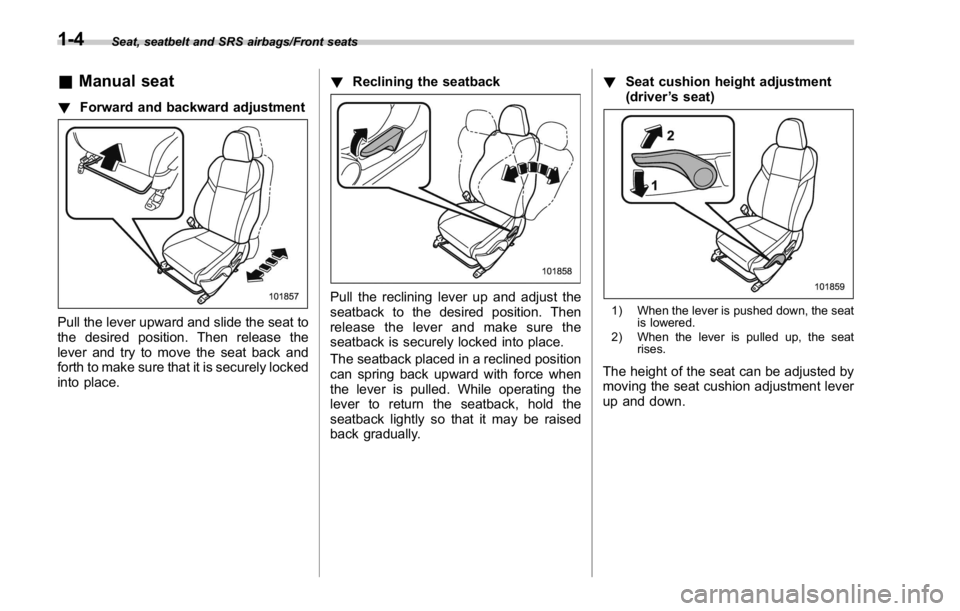
Seat, seatbelt and SRS airbags/Front seats
& Manual seat! Forward and backward adjustment
Pull the lever upward and slide the seat to
the desired position. Then release the
lever and try to move the seat back and
forth to make sure that it is securely locked
into place. ! Reclining the seatback
Pull the reclining lever up and adjust the
seatback to the desired position. Then
release the lever and make sure the
seatback is securely locked into place.
The seatback placed in a reclined position
can spring back upward with force when
the lever is pulled. While operating the
lever to return the seatback, hold the
seatback lightly so that it may be raised
back gradually. ! Seat cushion height adjustment
(driver ’ s seat)
1) When the lever is pushed down, the seat
is lowered.
2) When the lever is pulled up, the seat
rises.
The height of the seat can be adjusted by
moving the seat cushion adjustment lever
up and down.1-4
Page 35 of 594
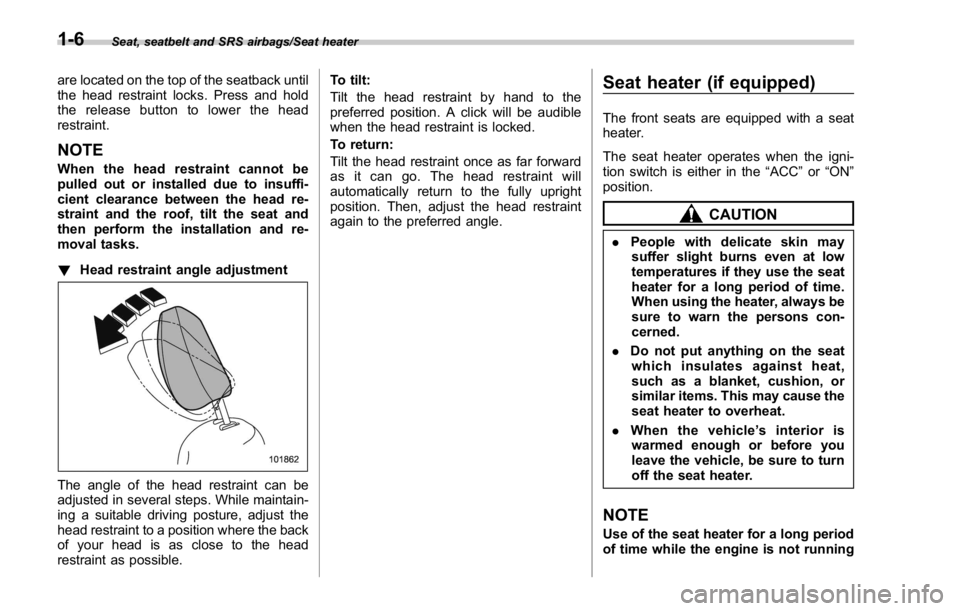
Seat, seatbelt and SRS airbags/Seat heater
are located on the top of the seatback until
the head restraint locks. Press and hold
the release button to lower the head
restraint.
NOTE When the head restraint cannot be
pulled out or installed due to insuffi-
cient clearance between the head re-
straint and the roof, tilt the seat and
then perform the installation and re-
moval tasks.
! Head restraint angle adjustment
The angle of the head restraint can be
adjusted in several steps. While maintain-
ing a suitable driving posture, adjust the
head restraint to a position where the back
of your head is as close to the head
restraint as possible. To tilt:
Tilt the head restraint by hand to the
preferred position. A click will be audible
when the head restraint is locked.
To return:
Tilt the head restraint once as far forward
as it can go. The head restraint will
automatically return to the fully upright
position. Then, adjust the head restraint
again to the preferred angle. Seat heater (if equipped) The front seats are equipped with a seat
heater.
The seat heater operates when the igni-
tion switch is either in the “ ACC ” or “ ON ”
position.
CAUTION. People with delicate skin may
suffer slight burns even at low
temperatures if they use the seat
heater for a long period of time.
When using the heater, always be
sure to warn the persons con-
cerned.
. Do not put anything on the seat
which insulates against heat,
such as a blanket, cushion, or
similar items. This may cause the
seat heater to overheat.
. When the vehicle ’ sinterioris
warmed enough or before you
leave the vehicle, be sure to turn
off the seat heater.
NOTE
Use of the seat heater for a long period
of time while the engine is not running1-6
Page 36 of 594
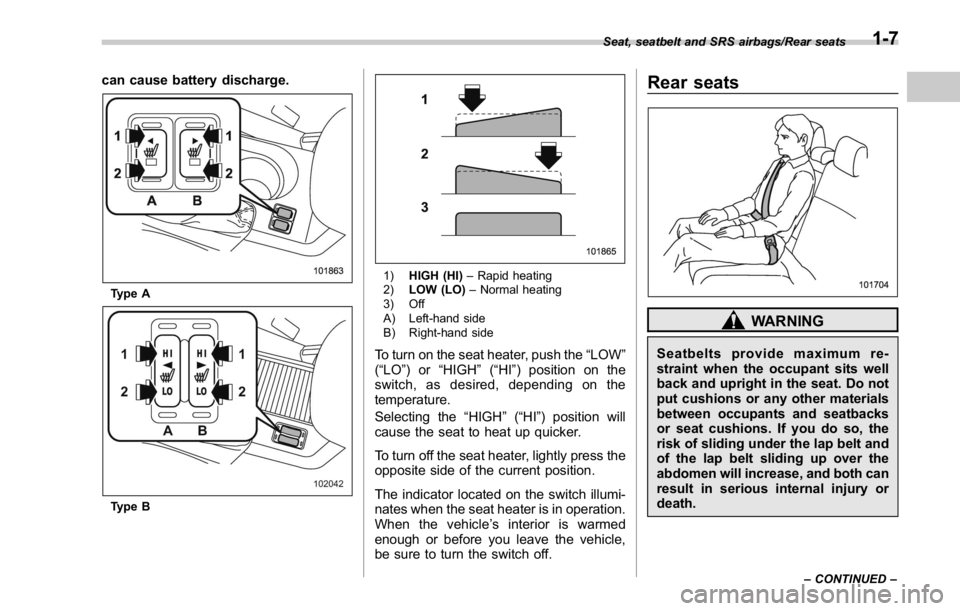
can cause battery discharge.
Type A
Type B 1) HIGH (HI) – Rapid heating
2) LOW (LO) – Normal heating
3) Off
A) Left-hand side
B) Right-hand side
To turn on the seat heater, push the “ LOW ”
( “ LO ” )or “ HIGH ” ( “ HI ” ) position on the
switch, as desired, depending on the
temperature.
Selecting the “ HIGH ” ( “ HI ” ) position will
cause the seat to heat up quicker.
To turn off the seat heater, lightly press the
opposite side of the current position.
The indicator located on the switch illumi-
nates when the seat heater is in operation.
When the vehicle ’ s interior is warmed
enough or before you leave the vehicle,
be sure to turn the switch off. Rear seats
WARNING
Seatbelts provide maximum re-
straint when the occupant sits well
back and upright in the seat. Do not
put cushions or any other materials
between occupants and seatbacks
or seat cushions. If you do so, the
risk of sliding under the lap belt and
of the lap belt sliding up over the
abdomen will increase, and both can
result in serious internal injury or
death. Seat, seatbelt and SRS airbags/Rear seats
– CONTINUED –1-7
Page 39 of 594
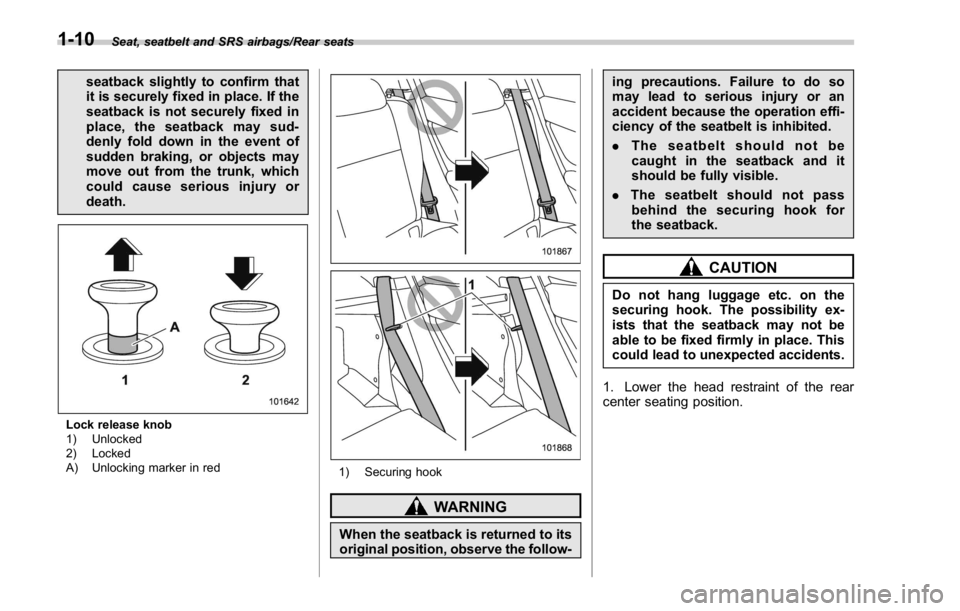
Seat, seatbelt and SRS airbags/Rear seats
seatback slightly to confirm that
it is securely fixed in place. If the
seatback is not securely fixed in
place, the seatback may sud-
denly fold down in the event of
sudden braking, or objects may
move out from the trunk, which
could cause serious injury or
death.
Lock release knob
1) Unlocked
2) Locked
A) Unlocking marker in red
1) Securing hook
WARNING
When the seatback is returned to its
original position, observe the follow- ing precautions. Failure to do so
may lead to serious injury or an
accident because the operation effi-
ciency of the seatbelt is inhibited.
. The seatbelt should not be
caught in the seatback and it
should be fully visible.
. The seatbelt should not pass
behind the securing hook for
the seatback.
CAUTIONDo not hang luggage etc. on the
securing hook. The possibility ex-
ists that the seatback may not be
able to be fixed firmly in place. This
could lead to unexpected accidents.
1. Lower the head restraint of the rear
center seating position.1-10
Page 41 of 594
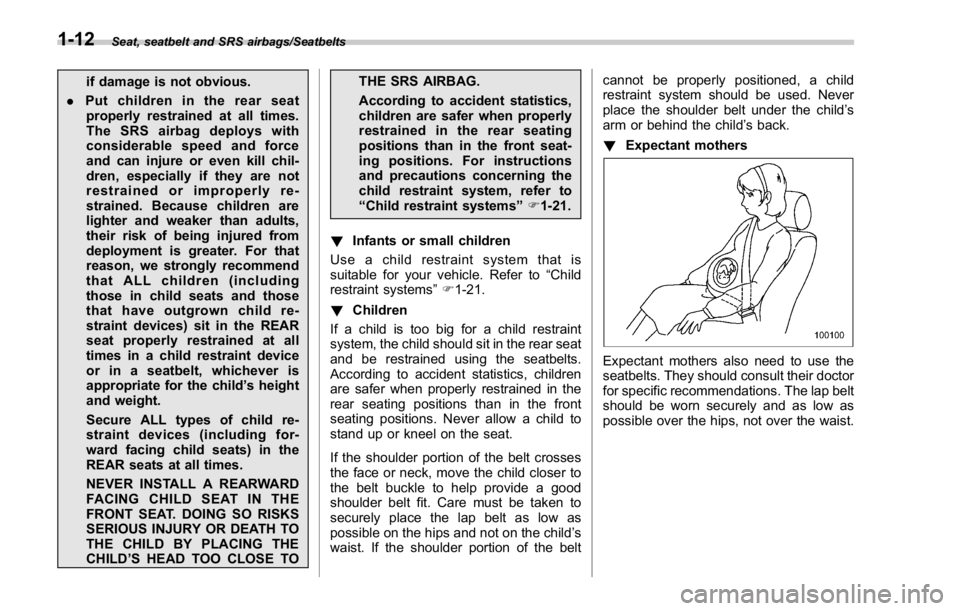
Seat, seatbelt and SRS airbags/Seatbelts
if damage is not obvious.
. Put children in the rear seat
properly restrained at all times.
The SRS airbag deploys with
considerable speed and force
and can injure or even kill chil-
dren, especially if they are not
restrained or improperly re-
strained. Because children are
lighter and weaker than adults,
their risk of being injured from
deployment is greater. For that
reason, we strongly recommend
that ALL children (including
those in child seats and those
that have outgrown child re-
straint devices) sit in the REAR
seat properly restrained at all
times in a child restraint device
or in a seatbelt, whichever is
appropriate for the child ’ s height
and weight.
Secure ALL types of child re-
straint devices (including for-
ward facing child seats) in the
REAR seats at all times.
NEVER INSTALL A REARWARD
FACING CHILD SEAT IN THE
FRONT SEAT. DOING SO RISKS
SERIOUS INJURY OR DEATH TO
THE CHILD BY PLACING THE
CHILD ’ S HEAD TOO CLOSE TO THE SRS AIRBAG.
According to accident statistics,
children are safer when properly
restrained in the rear seating
positions than in the front seat-
ing positions. For instructions
and precautions concerning the
child restraint system, refer to
“ Child restraint systems ” F 1-21.
! Infants or small children
Use a child restraint system that is
suitable for your vehicle. Refer to “ Child
restraint systems ” F 1-21.
! Children
If a child is too big for a child restraint
system, the child should sit in the rear seat
and be restrained using the seatbelts.
According to accident statistics, children
are safer when properly restrained in the
rear seating positions than in the front
seating positions. Never allow a child to
stand up or kneel on the seat.
If the shoulder portion of the belt crosses
the face or neck, move the child closer to
the belt buckle to help provide a good
shoulder belt fit. Care must be taken to
securely place the lap belt as low as
possible on the hips and not on the child ’ s
waist. If the shoulder portion of the belt cannot be properly positioned, a child
restraint system should be used. Never
place the shoulder belt under the child ’ s
arm or behind the child ’ s back.
! Expectant mothers
Expectant mothers also need to use the
seatbelts. They should consult their doctor
for specific recommendations. The lap belt
should be worn securely and as low as
possible over the hips, not over the waist.1-12
Page 42 of 594
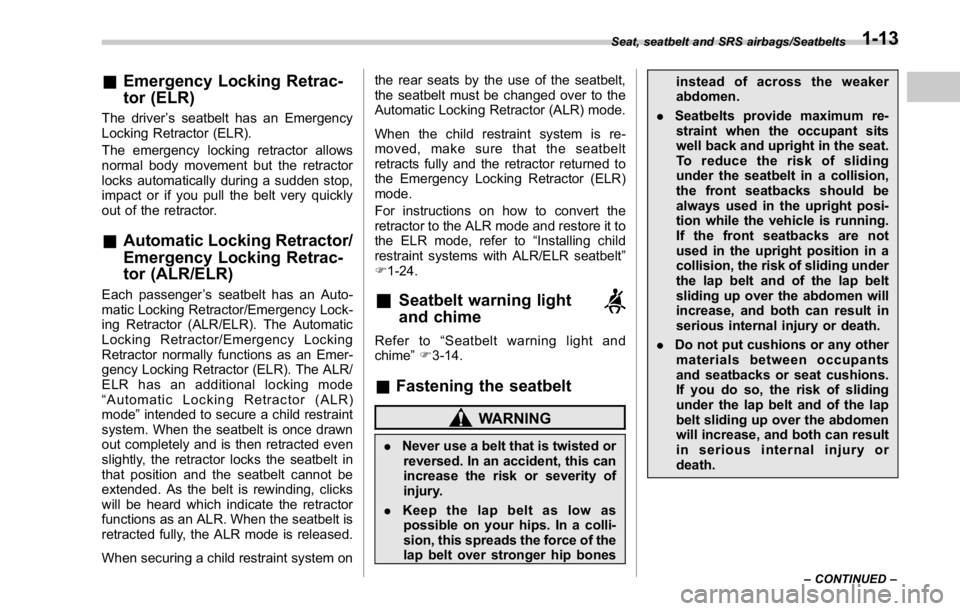
& Emergency Locking Retrac-
tor (ELR) The driver ’ s seatbelt has an Emergency
Locking Retractor (ELR).
The emergency locking retractor allows
normal body movement but the retractor
locks automatically during a sudden stop,
impact or if you pull the belt very quickly
out of the retractor.
& Automatic Locking Retractor/
Emergency Locking Retrac-
tor (ALR/ELR) Each passenger ’ s seatbelt has an Auto-
matic Locking Retractor/Emergency Lock-
ing Retractor (ALR/ELR). The Automatic
Locking Retractor/Emergency Locking
Retractor normally functions as an Emer-
gency Locking Retractor (ELR). The ALR/
ELR has an additional locking mode
“ Automatic Locking Retractor (ALR)
mode ” intended to secure a child restraint
system. When the seatbelt is once drawn
out completely and is then retracted even
slightly, the retractor locks the seatbelt in
that position and the seatbelt cannot be
extended. As the belt is rewinding, clicks
will be heard which indicate the retractor
functions as an ALR. When the seatbelt is
retracted fully, the ALR mode is released.
When securing a child restraint system on the rear seats by the use of the seatbelt,
the seatbelt must be changed over to the
Automatic Locking Retractor (ALR) mode.
When the child restraint system is re-
moved, make sure that the seatbelt
retracts fully and the retractor returned to
the Emergency Locking Retractor (ELR)
mode.
For instructions on how to convert the
retractor to the ALR mode and restore it to
the ELR mode, refer to “ Installing child
restraint systems with ALR/ELR seatbelt ”
F 1-24.
& Seatbelt warning light
and chime Refer to “ Seatbelt warning light and
chime ” F 3-14.
& Fastening the seatbelt
WARNING
. Never use a belt that is twisted or
reversed. In an accident, this can
increase the risk or severity of
injury.
. Keep the lap belt as low as
possible on your hips. In a colli-
sion, this spreads the force of the
lap belt over stronger hip bones instead of across the weaker
abdomen.
. Seatbelts provide maximum re-
straint when the occupant sits
well back and upright in the seat.
To reduce the risk of sliding
under the seatbelt in a collision,
the front seatbacks should be
always used in the upright posi-
tion while the vehicle is running.
If the front seatbacks are not
used in the upright position in a
collision, the risk of sliding under
the lap belt and of the lap belt
sliding up over the abdomen will
increase, and both can result in
serious internal injury or death.
. Do not put cushions or any other
materials between occupants
and seatbacks or seat cushions.
If you do so, the risk of sliding
under the lap belt and of the lap
belt sliding up over the abdomen
will increase, and both can result
in serious internal injury or
death. Seat, seatbelt and SRS airbags/Seatbelts
– CONTINUED –1-13